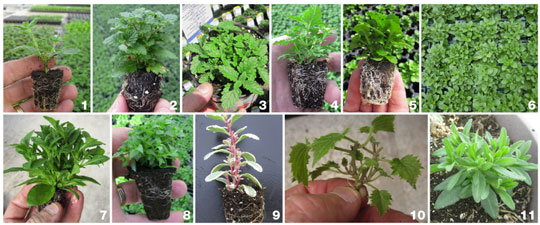9/25/2013
Daminozide & Ethephon for Improved Liners
Dr. Royal Heins

Height control, improved branching and flower management are three desirable outcomes from proper use of growth regulators in liner production. Many plant species—such as verbena, fuchsia and calibrachoa—will elongate during and just after the rooting process during propagation. Such elongation contributes to long internodes and, if such plants aren’t pinched carefully, the liner will have only one or two nodes left on the plant after pinch—which significantly reduces lateral branching potential (Figure 1). A much better liner is one where the internodes above the media are compact so that after pinching or mowing—at least two and preferably three or four nodes—are left to form lateral branches (Figure 2) resulting in a full plant in the finished pot (Figure 3).
Developing compact and well-branched liners first involves control of initial stretch and then promotion of lateral branching. Many growers have found application of daminozide (B-Nine, Dazide) at 2,500 ppm one or two days after sticking helps control the initial stretch that will occur in many cuttings as they root. Daminozide is an excellent growth retardant, as it has a wide efficacy range, similar effective concentration over many plant species and has a relatively short life in the plant so plants aren’t stunted after transplanting.
About the time a cutting has rooted to the edge of the liner cell, a second growth regulator application consisting of daminozide and ethephon (Florel, Collate) has been found to be very effective at controlling further elongation and promoting lateral branching. To my knowledge, Maury Mairs at Battlefield Farms was the first person to apply this tank-mix application to vegetative cuttings and to observe an enhanced branching response in addition to promotion of compact growth (Figure 4).
Since the first observations by Maury on Verbena, applications of the daminozide and ethephon tank mix have been made to many species by many growers. Response by most species has been very positive, resulting in compact and well-branched liners. A partial representation of plant species responses is shown in Figures 5 to 11.
If you haven’t trialed this tank mix on liners, consider doing so. Wait to apply the initial tank mix until the plants in the liner have formed roots—at least to the edge of the soil ball after sticking. A second application may be made two weeks later if desired to further enhance the branching response and to further develop compact liners.
Apply to wet the foliage (about 1.25 qt. per 100 sq. ft.), but don’t apply so heavily as to drench the soil. If excess volume is applied and the solution gets into the soil, rooting out of the liner into the final container can be delayed—in cases with large-volume applications to the soil, the delay has been up to two to three weeks.
The old saying, “If a little is good, more is better” definitely doesn’t apply with this tank mix. Applied properly, though, growers who’ve used this tank mix have found great value. If you haven’t used it, hopefully, you too will find value after trialing.
GT
Dr. Royal Heins is Senior Technical Specialist with Fides-Oro and can be reached at r.heins@fides-oro.com or on the company website. Go to www.fides-oro.com and click on “Ask the Doctor.”